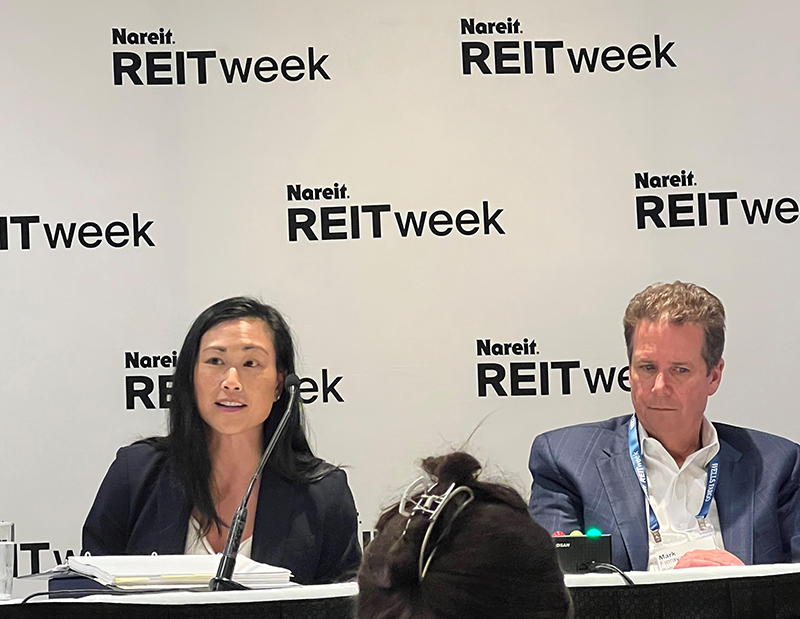REITWeek Special Report: REITs Get Real in Close-Up Sessions
Some 90 companies across all property types presented.

During REITWeek, REIT executives get an opportunity to “cut through the noise,” in the words of NAREIT President & CEO Steven Wechsler, and tell their stories directly to investors, potential investors and analysts.
The content for the four-day NAREIT-hosted conference being held in New York City this week consists largely of 30-minute panel discussions, each featuring a different senior REIT management team fielding questions from an analyst. Roughly 90 different REITs presented in rooms holding about 100 people.
READ ALSO: How Interest Rates Drag on REITs
REITs are fairly well cushioned in today’s “higher for longer” interest rate environment. At the end of the first quarter, the average REIT leverage ratio of debt to market assets was 33 percent; 79 percent of REITs’ total debt was unsecured; 89 percent was fixed rate, and the weighted average term to maturity was 6.5 years out, Kimco CEO Conor Flynn told attendees.
They also own the better assets in their property types, and are well-managed at a time when a clear strategy and fiscal discipline really matter. And their balance sheets leave them well-positioned to take advantage of acquisition opportunities when they arise later this year or early next year.
But while REITs do not have to go to traditional debt markets for capital, they are not immune to the impacts of higher rates and an uncertain economy. So conference attendees were interested to hear how the companies are managing current challenges as well as new opportunities.
Take, for example, office REIT Boston Properties. Though some brand-name sponsors have overleveraged and are facing distress situations, most of BXP’s debt is investment-grade unsecured. That has helped it attract tenants during this flight-to-quality period because it can fund the tenant improvements that companies are seeking, said BXP Chairman & CEO Owen Thomas.
“Our clients are much more attuned to sponsorship, which really plays to our advantage,” he said.

The company completed 880,000 square feet of leasing in the first quarter and currently has a pipeline of 1.7 million square feet, which is “substantially higher” than the past four quarters, according to Douglas Linde, the company’s president & director. The leasing was weighted on the East Coast rather than the West Coast, and it represented more expansions and larger expansions, Linde said.
“We are seeing confidence in businesses, and therefore decisions to do leases, and we are effectively eating a bigger piece of the pie,” he said. “The pie isn’t necessarily getting larger, but we are getting a far larger share of it.”
Big tech, where are you?
Speaking of the pie, Linde said emerging tech firms have helped Boston Properties “maintain and slightly grow” their occupancy, but the retreat of “big tech” is a concern for the company, which owns Salesforce Tower in San Francisco and is the largest landlord in that market. Meta, for example, is giving back 275,000 square feet in New York (not in a BXP building), Linde cited.
“Macro level, if we don’t see Google and Apple and Meta and Amazon and Microsoft taking meaningful large pieces of space, we’re not going to see this broad macro recovery anytime soon,” he said.
Life science is also having somewhat of a reckoning in key BXP markets like Boston, San Francisco and San Diego. While the company believes “wholeheartedly” in that marketplace, Linde expects that space’s growth trajectory to return to 2014-2017 levels, following the “exponential growth” of companies, and real estate inventories, during the cheap money days of 2021-2022.
“We are now dealing with the digesting of all that space and the change in the capital raising of those companies,” Linde said. “Neither the technology nor the life science market is anywhere close to where it was in 2020-2022, but we are as confident in life science as we are in technology.”
Work from home

But the market that is most challenging for the company is Washington, D.C., which it considers a “tertiary market” since BXP is mostly a Northern Virginia investor. While D.C. has been “historically stable,” the Federal government’s decision to adopt remote or hybrid work models and give up a considerable amount of space has created distress in the market. “There are more zombie buildings in D.C. than in any other market,” Linde said.
Meanwhile, there are few expanding tenants, and top-notch space is hard to find. “The nature of the D.C. building is that it is a short, squat building, and every law firm has a desire to be at the top of a short, squat building,” Linde said.
Waiting on the Fed
First Industrial Realty Trust owns 68.1 million assets in 15 key distribution markets around the country. It has low leverage, with no debt maturities until 2026, and it is well-positioned with land holdings, according to President & CEO Peter Baccile.
But industrial has struggled with some overbuilding and slower leasing in certain markets. As a result, Baccile said, there are a lot of “different rent numbers” flowing through the country. In Los Angeles, for example, rents are down double or triple from the pandemic-era peak.
Therefore, the company has a self-imposed development cap, and won’t move forward on new projects unless they are substantially leased. In the fourth quarter of last year, when the Fed indicated it might be ready to cut rates, Baccile said, the company saw “quicker decision-making” from prospective tenants. In its first-quarter earnings call, it announced a 1 million-square-foot lease in Stockton and a 500,000-square-foot lease in Nashville, Tenn. And while tenants became more “hesitant” in late March, when the Fed seemed to reverse course, they are still more decisive than most of 2023.
“We want to see new development leasing happening on a more consistent basis rather than one-off,” Baccile said.

One market Baccile foresees new development potentially occurring in this year is South Florida, which has a “permanent barrier to entry.” That market was 2 percent of First Industrial’s portfolio in 2020, and now it is 7 percent.
Acquisitions are also a challenge, Baccile said, because the pricing still doesn’t make sense.
Having recently agreed to sell two parcels of land to separate data center companies, Baccile was asked if the company was going to be getting involved in data center development. The company will not be building data centers, but it would welcome similar land deals.
“We’re going to make more on the land than we would building a building,” he said.
Time to heal
With banks retreating, mortgage REITs and other non-bank lenders are well-positioned to fill in the gaps and assist in the “healing process,” particularly for office, said Michael Mazzei, CEO & board member of BrightSpire Capital.
BrightSpire, formerly Colony Credit Real Estate Inc., is a mortgage REIT that lends across the capital stack and is 49 percent owned by institutional investors. Its management team is well-known in the mortgage and securitization markets.
“Whether you are a fund or a mortgage REIT, you are very excited about it,” Mazzei said. “Even the equity players want to be in debt. The debt is driving the bus.”
But in response to a question about the balance between defense and offense, President & COO Andrew Witt said the firm has “not been very active” on the origination side for the past two years, as it has been focusing on its existing loans.
Witt said the company has a fair amount of visibility on its 4 and 5 risk loans and it is working with those sponsors every day. But more importantly, it is working on its REO book and looking to redeploy capital from assets it has taken back.
“We are certainly finally able to look out and see enough clarity in the portfolio that we are starting to look at new opportunities from a financing perspective,” Witt said.







You must be logged in to post a comment.